New Occurrence of Pyroxenites in the Veria-Naousa Ophiolite (North Greece): Implications on Their Origin and Petrogenetic Evolution
Abstract
:1. Introduction
2. Geological Setting
3. Petrographic Features
3.1. Websterite
3.2. Ol-Orthopyroxenite
4. Analytical Methods
5. Mineral Chemistry
5.1. Orthopyroxene
5.2. Clinopyroxene
5.3. Olivine
5.4. Spinel-group Minerals
6. Whole-Rock Geochemistry
7. Geothermometry
8. Petrogenetic and Geodynamic Considerations
8.1. Origin of Ol-Orthopyroxenite and Websterite
8.2. Tectonic Setting
9. Conclusions
Acknowledgments
Author Contributions
Conflicts of Interest
References
- Dilek, Y.; Furnes, H. Ophiolites and Their Origins. Mineral. Soc. Am. 2014, 1811–5209. [Google Scholar] [CrossRef]
- Magganas, A.; Koutsovitis, P. Composition, melting and evolution of the upper mantle beneath the Jurassic Pindos ocean inferred by ophiolitic ultramafic rocks in East Othris, Greece. Int. J. Earth Sci. 2015, 104, 1185–1207. [Google Scholar] [CrossRef]
- Ribeiro, A.; Munhá, J.; Fonseca, P.E.; Araújo, A.; Pedro, J.C.; Mateus, A.; Tassinari, C.; Machado, C.; Jesus, A. Variscan ophiolite belts in the Ossa-Morena Zone (Southwest Iberia): Geological characterization and geodynamic significance. Gondwana Res. 2010, 17, 408–421. [Google Scholar] [CrossRef]
- Pearce, J.A.; Robinson, P.T. The Troodos ophiolite complex probably formed in a subduction initiation, slab edge setting. Gondwana Res. 2010, 17, 60–81. [Google Scholar] [CrossRef]
- Chetty, T.R.K.; Yellappa, T.; Nagesh, P.; Mohanty, D.P.; Venkatasivappa, V.; Santosh, M.; Tsunogae, T. Structural anatomy of a dismembered ophiolite suite from Gondwana: The Manamedu complex, Cauvery suture zone, southern India. J. Asian Earth Sci. 2011, 42, 176–190. [Google Scholar] [CrossRef]
- Allahyari, K.; Saccani, E.; Rahimzadeh, B.; Zeda, O. Mineral chemistry and petrology of highly magnesian ultramafic cumulates from the Sarve-Abad (Sawlava) ophiolites (Kurdistan, NW Iran): New evidence for boninitic magmatism in intra-oceanic fore-arc setting in the Neo-Tethys between Arabia and Iran. J. Asian Earth Sci. 2014, 79, 312–328. [Google Scholar] [CrossRef]
- Whattam, S.A.; Stern, R.J. The ‘subduction initiation rule’: A key for linking ophiolites, intra-oceanic forearcs and subduction. Contrib. Mineral. Petrol. 2011, 162, 1031–1045. [Google Scholar] [CrossRef]
- Rizeli, M.E.; Beyarslan, M.; Wang, K.L.; Bingöl, A.F. Mineral chemistry and petrology of mantle peridotites from the Guleman ophiolite (SE Anatolia, Turkey): Evidence of a forearc setting. J. Afr. Earth Sci. 2016, 123, 392–402. [Google Scholar] [CrossRef]
- Rampone, E.; Hofmann, A.W.; Piccardo, C.B.; Vannucci, R.; Bottazzi, P.; Ottolini, L. Petrology, mineral and isotope geochemistry of the external Liguride peridotites (Northern Apennines, Italy). J. Petrol. 2005, 36, 81–105. [Google Scholar] [CrossRef]
- Schmädicke, E.; Gose, J.; Will, T.M. High-temperature metamorphism of garnet-bearing ultramafic rocks from the Saxonian Granulite Core Complex, Germany. J. Metamorph. Geol. 2010, 28, 489–508. [Google Scholar] [CrossRef]
- Bodinier, J.L.; Garrido, C.J.; Chanefo, I.; Bruguier, O.; Gervilla, F. Origin of Pyroxenite-Peridotite Veined Mantle by Refertilization Reactions: Evidence from the Ronda Peridotite (Southern Spain). J. Petrol. 2008, 49, 999–1025. [Google Scholar] [CrossRef]
- Montanini, A.; Tribuzio, R.; Thirwall, M. Garnet clinopyroxenite layers from the mantle sequences of the Northern Apennine ophiolites (Italy): Evidence for recycling of crustal material. Earth Planet Sci. Lett. 2012, 351–352, 171–181. [Google Scholar] [CrossRef]
- Schmädicke, E.; Okrusch, M.; Will, T. Garnet pyroxenite, eclogite and alkremite xenoliths from the off-craton Gibeon kimberlite field, Namibia: A window into the upper mantle of the Rehoboth Terrane. Precamb. Res. 2011, 191, 1–17. [Google Scholar] [CrossRef]
- Schmädicke, E.; Will, T.; Mezger, K. Garnet pyroxenite from the Shackleton Range, Antarctica: Intrusion of plume-derived picritic melts in the continental lithosphere during Rodinia breakup. Lithos 2015, 238, 185–206. [Google Scholar] [CrossRef]
- Bizimis, M.; Sen, G.; Salters, V.J.M.; Keshav, S. Hf-Nd-Sr isotope systematics of garnet pyroxenites from Salt Lake Crater, Oahu, Hawaii: Evidence for a depleted component in Hawaii volcanism. Geochim. Cosmochim. Acta 2005, 69, 2629–2646. [Google Scholar] [CrossRef]
- Hirschmann, M.M.; Stolper, E.M. A possible role for garnet pyroxenite in the origin of the ‘garnet signature’ in MORB. Contrib. Mineral. Petrol. 1996, 124, 185–208. [Google Scholar] [CrossRef]
- Hirschmann, M.M.; Kogisto, T.; Baker, M.B.; Stolper, E.M. Alkalic magmas generated by partial melting of garnet pyroxenite. Geology 2003, 31, 481–483. [Google Scholar] [CrossRef]
- Sobolev, A.V.; Hofmann, A.W.; Sobolev, S.V.; Nikogosian, I.K. An olivine-free mantle source of Hawaiian shield basalts. Nature 2005, 434, 590–597. [Google Scholar] [CrossRef] [PubMed]
- Tuff, J.; Takahashi, E.; Gibson, S.A. Experimental constraints on the role of garnet pyroxenite in the genesis of High-Fe mantle plume derived melts. J. Petrol. 2005, 46, 2023–2058. [Google Scholar] [CrossRef]
- Schiano, P.; Eiler, J.M.; Hutcheon, I.D.; Stolper, E.M. Primitive CaO-rich, silica-undersaturated melts in island arcs, evidence for the involvement of clinopyroxene-rich lithologies in the petrogenesis of arc magmas. Geochem. Geophys. Geosyst. 2000, 1. [Google Scholar] [CrossRef]
- Lee, C.T.A.; Cheng, X.; Horodyskyi, U. The development and refinement of continental arcs by primary basaltic magmatism, garnet pyroxenite accumulation, basaltic recharge and delamination: Insights from the Sierra Nevada. Contrib. Mineral. Petrol. 2006, 151, 222–242. [Google Scholar] [CrossRef]
- Esna-Ashari, A.; Tiepolo, M.; Hassanzadeh, J. On the occurrence and implications of Jurassic primary continental boninite-like melts in the Zagros orogeny. Lithos 2016, 258–259, 37–57. [Google Scholar] [CrossRef]
- Herzberg, C. Identification of source lithology in the Hawaiian and Canary Islands: Implications for origins. J. Petrol. 2011, 52, 113–146. [Google Scholar] [CrossRef]
- Frets, E.; Tommasi, A.; Garrido, C.J.; Padrón-Navarta, J.A.; Amri, I.; Targuisti, K. Deformation processes and rheology of pyroxenites under lithospheric mantle conditions. J. Struct. Geol. 2012, 39, 138–157. [Google Scholar] [CrossRef]
- Ying, J.F.; Zhang, H.F.; Tang, Y.J.; Su, B.X.; Zhou, X.H. Diverse crustal components in pyroxenite xenoliths from Junan, Sulu orogenic belt: Implications for lithospheric modification invoked by continental subduction. Chem. Geol. 2013, 356, 181–192. [Google Scholar] [CrossRef]
- Su, B.X.; Chung, S.L.; Zarrinkoub, M.H.; Pang, K.N.; Chen, L.; Ji, W.Q.; Brewer, A.; Ying, J.F.; Khatib, M.M. Composition and structure of the lithospheric mantle beneath NE Iran: Constraints from mantle xenoliths. Lithos 2014, 202–203, 267–282. [Google Scholar] [CrossRef]
- Downes, H. Origin and significance of spinel and garnet pyroxenites in the shallow lithospheric mantle: Ultramafic massifs in orogenic belts in Western Europe and NW Africa. Lithos 2007, 99, 1–24. [Google Scholar] [CrossRef]
- Borghini, G.; Rampone, E.; Zanetti, A.; Class, C.; Cipriani, A.; Hofmann, A.W.; Goldstein, S.L. Pyroxenite Layers in the Northern Apennines’ Upper Mantle (Italy)-Generation by Pyroxenite Melting and Melt Infiltration. J. Petrol. 2016, 57, 625–653. [Google Scholar] [CrossRef]
- Liu, Y.S.; Gao, S.; Lee, C.T.; Hu, S.H.; Liu, X.M.; Yuan, H.L. Melt-peridotite interactions: Links between garnet pyroxenite and high Mg# signature of Continental crust. Earth Planet. Sci. Lett. 2005, 234, 39–57. [Google Scholar]
- Marchesi, G.; Garrido, C.J.; Bosch, D.; Bodinier, J.L.; Gervilla, F.; Hidas, K. Mantle refertilization by melts of crustal-derived garnet pyroxenite: Evidence from the Ronda peridotite massif, southern Spain. Earth Planet. Sci. Lett. 2013, 362, 66–75. [Google Scholar] [CrossRef]
- Zhang, H.F.; Deloule, E.; Tang, Y.J.; Ying, J.F. Melt/rock interaction in remains of refertilized Archean lithospheric mantle in Jiaodong Peninsula, North China Craton: Li isotopic evidence. Contrib. Miner. Petrol. 2010b, 160, 261–277. [Google Scholar] [CrossRef]
- Seyler, M.; Lorand, J.P.; Dick, H.J.B.; Drouin, M. Pervasive melt percolation reactions in ultra-depleted refractory harzburgites at the Mid-Atlantic Ridge, 15°2’ N: ODP hole 1274A. Contrib. Miner. Petrol. 2007, 153, 303–319. [Google Scholar] [CrossRef]
- Mercier, J.; Vergely, P.; Bebien, J. Les Ophiolites helléniques “obductées” au Jurassique supérieur sont-elles les vestiges d’ un océan Tethysien ou d’ une mer marginale péri-européenne ? C.R. Somm. Soc. Geol. Fr. 1975, 4, 108–112. [Google Scholar]
- Economou, M. A short note on the evolution of the Vermion ophiolite complex (Macedonia-Greece). Ofioliti 1983, 8, 333–338. [Google Scholar]
- Michailidis, K.M. Zoned chromites with high Mn-contents in the Fe-Ni-Cr-laterite ore deposits from the Edessa area in Northern Greece. Miner. Deposita 1990, 25, 190–197. [Google Scholar] [CrossRef]
- Economou-Eliopoulos, M. Apatite and Mn. Zn. Co-enriched chromite in Ni-laterites of northern Greece and their genetic significance. J. Geochem. Explor. 2003, 80, 41–54. [Google Scholar] [CrossRef]
- Tsoupas, G.; Economou-Eliopoulos, M. High PGE contents and extremely abundant PGE-minerals hosted in chromitites from the Veria ophiolite complex. Northern Greece. Ore Geol. Rev. 2008, 33, 3–19. [Google Scholar] [CrossRef]
- Pirard, C.; Hermann, J.; O’Neill, H.S.C. Petrology and Geochemistry of the Crust-Mantle Boundary in a Nascent Arc, Massif du Sud Ophiolite, New Caledonia, SW Pacific. J. Petrol. 2013, 54, 1759–1792. [Google Scholar] [CrossRef]
- De Hoog, J.C.M.; Gall, L.; Cornell, D. Trace element geochemistry of mantle olivine and applications to mantle petrogenesis and geothermobarometry. Chem. Geol. 2010, 270, 196–215. [Google Scholar] [CrossRef]
- Dick, H.J.B.; Bullen, T. Chromian spinel as a petrogenetic indicator in abyssal and alpine-type peridotites and spatially associated lavas. Contrib. Mineral. Petrol. 1984, 86, 54–76. [Google Scholar] [CrossRef]
- Arai, S. Chemistry of chromian spinel in volcanic rocks as a potential guide to magma chemistry. Mineral. Mag. 1992, 56, 173–184. [Google Scholar] [CrossRef]
- Jan, M.Q.; Windley, B.F. Chromian spinel-silicate chemistry in ultramafic rocks of the Jijal complex, Northwestern Pakistan. J. Petrol. 1990, 31, 667–715. [Google Scholar] [CrossRef]
- Kamenetsky, V.S.; Crawford, A.J.; Meffre, S. Factors controlling chemistry of magmatic spinel: An empirical study of associated olivine, Cr-spinel and melt inclusions from primitive rocks. J. Petrol. 2011, 42, 655–671. [Google Scholar] [CrossRef]
- Gravestock, P.J. The Chemical Causes of Uppermost Mantle Heterogeneities. Ph.D. Thesis, Open University, Milton Keynes, UK, 1992; p. 299. [Google Scholar]
- Santos, J.F.; Schärer, U.; Gil Ibargughi, J.I.; Girardeau, J. Genesis of Pyroxenite-rich Peridotite at Cabo Ortegal (NW Spain): Geochemical and Pb-Sr-Nd Isotope Data. J. Petrol. 2002, 43, 17–43. [Google Scholar] [CrossRef]
- McDonough, W.F.; Sun, S.S. The composition of the Earth. Chem. Geol. 1995, 120, 223–253. [Google Scholar] [CrossRef]
- Wood, B.; Banno, S. Garnet-orthopyroxene and orthopyroxene-clinopyroxene relationships in simple and complex systems. Contrib. Mineral. Petrol. 1973, 42, 109–124. [Google Scholar] [CrossRef]
- Kaczmarek, M.A.; Müntener, O. Juxtaposition of melt impregnation and high temperature shear zones in the upper mantle. Field and petrological constraints from the Lanzo peridotite, (N-Italy). J. Petrol. 2008, 49, 2187–2220. [Google Scholar] [CrossRef]
- Suhr, G.; Kelemen, P.; Paulick, H. Microstructures in Hole 1274A peridotites, ODP Leg 209, Mid-Atlantic Ridge: Tracking the fact of melts percolating in peridotite as the lithosphere is intercepted. Geochem. Geophys. 2008, 9, 1–23. [Google Scholar] [CrossRef]
- Kelemen, P.B.; Hart, S.R.; Bernstein, S. Silica enrichment in the continental upper mantle via melt/rock reaction. Earth Planet Sci. Lett. 1998, 164, 387–406. [Google Scholar] [CrossRef]
- Le Roux, V.; Bodinier, J.L.; Tommasi, A.; Alard, O.; Dautria, J.M.; Vauchez, A.; Riches, A.J.V. The Lherz spinel lherzolite: Refertilized rather than pristine mantle. Earth Planet Sci. Lett. 2007, 259, 599–612. [Google Scholar] [CrossRef]
- Garrido, C.J.; Bodinier, J.L. Diversity of mafic rocks in the Ronda peridotite: Evidence for pervasive melt-rock reaction during heating of subcontinental lithosphere by upwelling asthenosphere. J. Petrol. 1999, 40, 729–754. [Google Scholar] [CrossRef]
- Soustelle, V.; Tommasi, A.; Bodinier, J.L.; Garrido, C.J.; Vauchez, A. Deformation and reactive melt transport in the mantle lithosphere above a large-scale partial melting domain: The Ronda Peridotite Massif, Southern Spain. J. Petrol. 2009, 50, 1235–1266. [Google Scholar] [CrossRef]
- Tilhac, R.; Ceuleneer, G.; Griffin, W.L.; O’Reilly, S.; Pearson, N.J.; Benoit, M.; Henry, H.; Girardeau, J.; Grégoire, M. Primitive Arc Magmatism and Delamination: Petrology and Geochemistry of Pyroxenites from the Cabo Ortegal Complex, Spain. J. Petrol. 2016, 57, 1921–1954. [Google Scholar] [CrossRef]
- Laukert, G.; Handt, A.V.D.; Hellebrand, E.; Snow, J.E.; Hoppe, P.; Klügel, A. High-pressure Reactive Melt Stagnation Recorded in Abyssal Pyroxenites from the Ultraslow-spreading Lena Trough, arctic Ocean. J. Petrol. 2014, 55, 427–458. [Google Scholar] [CrossRef]
- Schiano, P.; Clocchiatti, R.; Shimizu, N.; Maury, R.C.; Jochum, K.P.; Hofmann, A.W. Hydrous silica-rich melts in the sub-arc mantle and their relationships with erupted arc lavas. Nature 1995, 377, 595–600. [Google Scholar] [CrossRef]
- Prouteau, G.; Scaillet, B.; Pichavant, M.; Maury, R. Evidence for mantle metasomatism by hydrous silicic melts derived from subducted oceanic crust. Nature 2001, 410, 197–200. [Google Scholar] [CrossRef] [PubMed]
- Manning, C.E. The chemistry of subduction zone fluids. Earth Planet Sci. Lett. 2004, 223, 1–16. [Google Scholar] [CrossRef]
- Hermann, J.; Spandler, C.; Hack, A.; Korsakov, A.V. Aqueous fluids and hydrous melts in high-pressure rocks: Implications for element transfer in subduction zone. Lithos 2006, 92, 399–417. [Google Scholar] [CrossRef]
- Arai, S.; Takada, S.; Michibayashi, K.; Kida, M. Petrology of peridotite xenoliths from Iraya Volcano, Philippines, and implication for dynamic mantle-wedge processes. J. Petrol. 2004, 45, 369–389. [Google Scholar] [CrossRef]
- Downes, H.; Macdonald, R.; Upton, B.G.J.; Cox, K.G.; Bodinier, J-L.; Mason, P.R.D.; James, D.; Hill, P.G.; Hearn, B.C., Jr. Ultramafic xenoliths from the Bearpaw Mountains, Montana, USA: Evidence for multiple metasomatic events in the lithospheric mantle beneath the Wyoming craton. J. Petrol. 2004, 45, 1631–1662. [Google Scholar] [CrossRef]
- Ishimaru, S.; Arai, S. Peculiar Mg-Ca-Si metasomatism along a shear zone within the mantle wedge: Inference from fine-grained xenoliths from Avacha volcano, Kamchatka. Contr. Mineral. Petrol. 2011, 161, 703–720. [Google Scholar] [CrossRef]
- Soustelle, V.; Tommasi, A.; Demouchy, S.; Ionov, D.A. Deformation and Fluid-Rock Interaction in the Supra-subduction Mantle: Microstructures and Water Contents in Peridotite Xenoliths from the Avacha volcano, Kamchatka. J. Petrol. 2010, 51, 363–394. [Google Scholar] [CrossRef]
- Malaspina, N.; Herman, J.; Scambelluri, M.; Compagnoni, R. Polyphase inclusions in garnet-orthopyroxenite (Dabie Shan, China) as monitors for metasomatism and fluid-related trace element transfer in subduction zone. Earth Planet Sci. Lett. 2006, 249, 173–187. [Google Scholar] [CrossRef]
- Vrijmoed, J.C.; Austrheim, H.; John, T.; Hin, R.C.; Corfu, F.; Davies, G.R. Metasomatism in the ultrahigh-pressure Svarberget garnet-peridotite (Western Gneiss Region, Norway): Implications for the transport of crust derived-fluids within the mantle. J. Petrol. 2013, 54, 1815–1848. [Google Scholar] [CrossRef]
- Milke, R.; Kolzer, K.; Koch-Müller, M.; Wunder, B. Orthopyroxene rim growth between olivine and quartz at low temperatures (750–950 °C) and low water concentration. Minerl. Petrol. 2009, 97, 223–232. [Google Scholar] [CrossRef]
- Milke, R.; Abart, R.; Keller, L.; Rhede, D. The behavior of Mg, Fe and Ni during the replacement of olivine dy orthopyroxene: Experiments relevant to mantle metasomatism. Minerl. Petrol. 2011, 103, 1–8. [Google Scholar] [CrossRef]
- Gardés, E.; Wunder, B.; Marquardt, K.; Heinrich, W. The effect of water on intergranular mass transport: New insights from diffusion-controlled reaction rims in the MgO-SiO2 system. Contr. Mineral. Petrol. 2012, 164, 1–16. [Google Scholar] [CrossRef]
- Grant, T.B.; Harlov, D.E.; Rhede, D. Special collection: New advances in subduction zone magma genesis: Experimental formation of pyroxenite veins by reactions between olivine and Si, Al, Ca, Na, and Cl-rich fluids at 800 °C and 800 MPa: Implications for fluid metasomatism in the mantle wedge. Am. Mineral. 2016, 101, 808–818. [Google Scholar] [CrossRef]
- Smith, D.; Riter, J.C.A.; Mertzman, S.A. Water-rock interactions, orthopyroxene growth, and Si-enrichment in the mantle: Evidence in xenoliths from Colorado Plateau, southwestern United States. Earth Planet Sci. Lett. 1999, 165, 45–54. [Google Scholar] [CrossRef]
- McInnes, B.I.A.; Gregoire, M.; Binns, R.A.; Herzig, P.M.; Hannington, M.D. Hydrous metasomatism of oceanic sub-arc mantle, Lihir, Papua New Guinea: Petrology and geochemistry of fluid-metasomatised mantle wedge xenoliths. Earth Planet Sci. Lett. 2001, 188, 169–183. [Google Scholar] [CrossRef]
- Arai, S.; Miura, M. Formation and modification of chromitites in the mantle. Lithos 2016, 264, 277–295. [Google Scholar] [CrossRef]
- Barth, M.G.; Mason, P.; Davies, G.R.; Drury, M.R. The Othris Ophiolite, Greece: A snapshot of subduction initiation at a mid-ocean ridge. Lithos 2008, 100, 234–254. [Google Scholar] [CrossRef]
- Bizimis, M.; Salters, V.; Bonatti, E. Trace and REE content of clinopyroxenes from supra-subduction zone peridotites. Implications for melting and enrichment processes in island arcs. Chem. Geol. 2000, 165, 67–85. [Google Scholar] [CrossRef]
- Ulrich, M.; Picard, C.; Guillot, S.; Chauvel, C.; Cluzel, D.; Meffre, S. Multiple melting stages and refertilization as indicators for ridge to subduction formation: The New Caledonia ophiolite. Lithos 2010, 115, 223–236. [Google Scholar] [CrossRef] [Green Version]
- König, S.; Münker, C.; Schuth, S.; Luguet, A.; Hoffmann, J.E.; Kuduon, J. Boninites as windows into trace element mobility in subduction zones. Geochim. Cosmochic. Acta 2010, 74, 684–704. [Google Scholar] [CrossRef]
- Cluzel, D.; Ulrich, M.; Jourdan, F.; Meffre, S.; Paquette, J.L.; Audet, M.A.; Secchiari, A.; Maurizot, P. Early Eocene clinoenstatite boninite and boninite-series dikes of the ophiolite of New Caledonia; a witness of slab-derived enrichment of the mantle wedge in a nascent volcanic arc. Lithos 2016, 260, 429–442. [Google Scholar] [CrossRef]
- Deschamps, F.; Godard, M.; Guillot, S.; Hattori, K. Geochemistry of subduction zone serpentinites: A review. Lithos 2013, 178, 96–127. [Google Scholar] [CrossRef]
- Müntener, O.; Kelemen, P.B.; Grove, T.L. The role of H2O during crystallization of primitive arc magmas under uppermost mantle conditions and genesis of igneous pyroxenites: An experimental study. Contr. Mineral. Petrol. 2001, 141, 643–658. [Google Scholar] [CrossRef]
- Zangana, N.A.; Downes, H.; Thirlwall, M.F.; Hegner, E. Relationship between deformation, equilibration temperatures, REE and radiogenic isotopes in mantle xenoliths (Ray Pic, Massif Central, France): An example of plume-lithosphere interaction? Contr. Mineral. Petrol. 1997, 39, 1917–1930. [Google Scholar] [CrossRef]
- Barsdell, M.; Berry, R.F. Origin and evolution of primitive island arc ankaramites from Western Epi, Vanuatu. J. Petrol. 1990, 31, 747–777. [Google Scholar] [CrossRef]
- Eggins, S.M. Origin and differentiation of picritic arc lavas from Aoba (Ambae), Vanuatu. Contrib. Mineral. Petrol. 1993, 114, 79–100. [Google Scholar] [CrossRef]
- Ionov, D.A.; Dupuy, C.; O’Reilly, S.Y.; Kopylova, M.G.; Genshaft, Y.S. Carbonated peridotite xenoliths from Spitsbergen: Implications for trace elements signature of mantle carbonate metasomatism. Earth Planet Sci. Lett. 1993, 119, 283–297. [Google Scholar] [CrossRef]
- Yaxley, G.M.; Green, D.H.; Kamenetsky, V. Carbonatite metasomatism in southern Australia lithosphere. J. Petrol. 1998, 39, 1917–1930. [Google Scholar] [CrossRef]
- Downes, H. Formation and modification of the shallow subcontinental lithospheric mantle: A review of geochemical evidence from ultramafic xenolith suites and tectonically emplaced ultramafic massifs of Western and Central Europe. J. Petrol. 2001, 42, 233–250. [Google Scholar] [CrossRef]
- Tsikouras, B.; Karipi, S.; Rigopoulos, I.; Perraki, M.; Pomonis, P.; Hatzipanagiotou, K. Geochemical processes and petrogenetic evolution of rodingite dykes in the ophiolite complex of Othrys (Central Greece). Lithos 2009, 113, 540–554. [Google Scholar] [CrossRef]
- Tsikouras, B.; Karipi, S.; Hatzipanagiotou, K. Evolution of rodingites along stratigraphic depth in the Iti and Kallidromon ophiolites (Central Greece). Lithos 2013, 175–176, 16–29. [Google Scholar] [CrossRef]
- Green, D.H.; Fallon, T.J. Pyrolite: A Ringwood concept and its current expression. In The Earth’s Mantle: Composition, Structure and Evolution; Jackson, I.N.S., Ed.; Cambridge University Press: Cambridge, UK, 1998; pp. 331–380. [Google Scholar]
- Schmidt, M.W.; Green, D.H.; Hibberson, W.O. Ultracalcic magmas generated from Ca-depleted mantle: An experimental study on the origin of ankaramites. J. Petrol. 2004, 45, 531–554. [Google Scholar] [CrossRef]
- Green, D.H.; Schmidt, M.W.; Hibberson, W.O. Island-arc ankaramites: Primitive melts from fluxed refractory lherzolitic mantle. J. Petrol. 2004, 45, 391–403. [Google Scholar] [CrossRef]
- Koloskov, A.V.; Zharinov, S.E. Multivariate statistical analysis of clinopyroxene compositions from mafic and ultramafic xenoliths in volcanic rocks. J. Petrol. 1993, 34, 173–185. [Google Scholar] [CrossRef]
- Buccianti, A.; Vaselli, O. An introduction to the multivariate statistical analysis of compositional data: Applications to classification problems of clinopyroxenes from mafic and ultramafic rocks. Mineral. Petrogr. Acta 1996, 39, 275–289. [Google Scholar]
- Parkinson, I.J.; Pearce, J.A. Peridotites from the Izu-Bonin-Mariana forearc (ODP Leg 125): Evidence for mantle melting and melt-mantle interaction in a supra-subduction zone setting. J. Petrol. 1998, 39, 1577–1618. [Google Scholar] [CrossRef]
- Obata, M. Petrology and Petrogenesis of the Ronda High-Temperature Peridotite Intrusion, Southern Spain. Ph.D. Thesis, Massachusetts Institute of Technology, Cambridge, MA, USA, 1977; p. 247. [Google Scholar]
- Gaggero, L.; Cortesogno, L. Metamorphic evolution of oceanic gabbros: Recrystallization from solidus to hydrothermal conditions in the MARK area (ODP Leg 153). Litthos 1997, 40, 105–131. [Google Scholar] [CrossRef]
- Flower, M.F.J.; Robinson, P.T.; Schmincke, H.U.; Ohnmacht, W. Magma fractionation systems beneath the Mid-Atlantic ridge at 36–37-N. Contrib. Mineral. Petrol. 1977, 74, 361–374. [Google Scholar] [CrossRef]
- Singh, A.K.; Nayak, R.; Khogenkumar, S.; Subramanyam, K.S.V.; Thakur, S.S.; Singh, R.K.B.; Satyanarayanan, M. Genesis and tectonic implications of cumulate pyroxenites and tectonite peridotites from the Nagaland-Manipur ophiolites, Northeast India: Constraints from mineralogical and geochemical characteristics. Geol. J. 2016. [Google Scholar] [CrossRef]
- Uysal, I.; Ersoy, Y.E.; Dilek, Y.; Kapsiotis, A.; Sarifakioglu, E. Multiple episodes of partial melting, depletion, metasomatism and enrichment processes recorded in the heterogeneous upper mantle sequence of the Neotethyan Eldivan ophiolite, Turkey. Lithos 2016, 246–247, 228–245. [Google Scholar] [CrossRef]
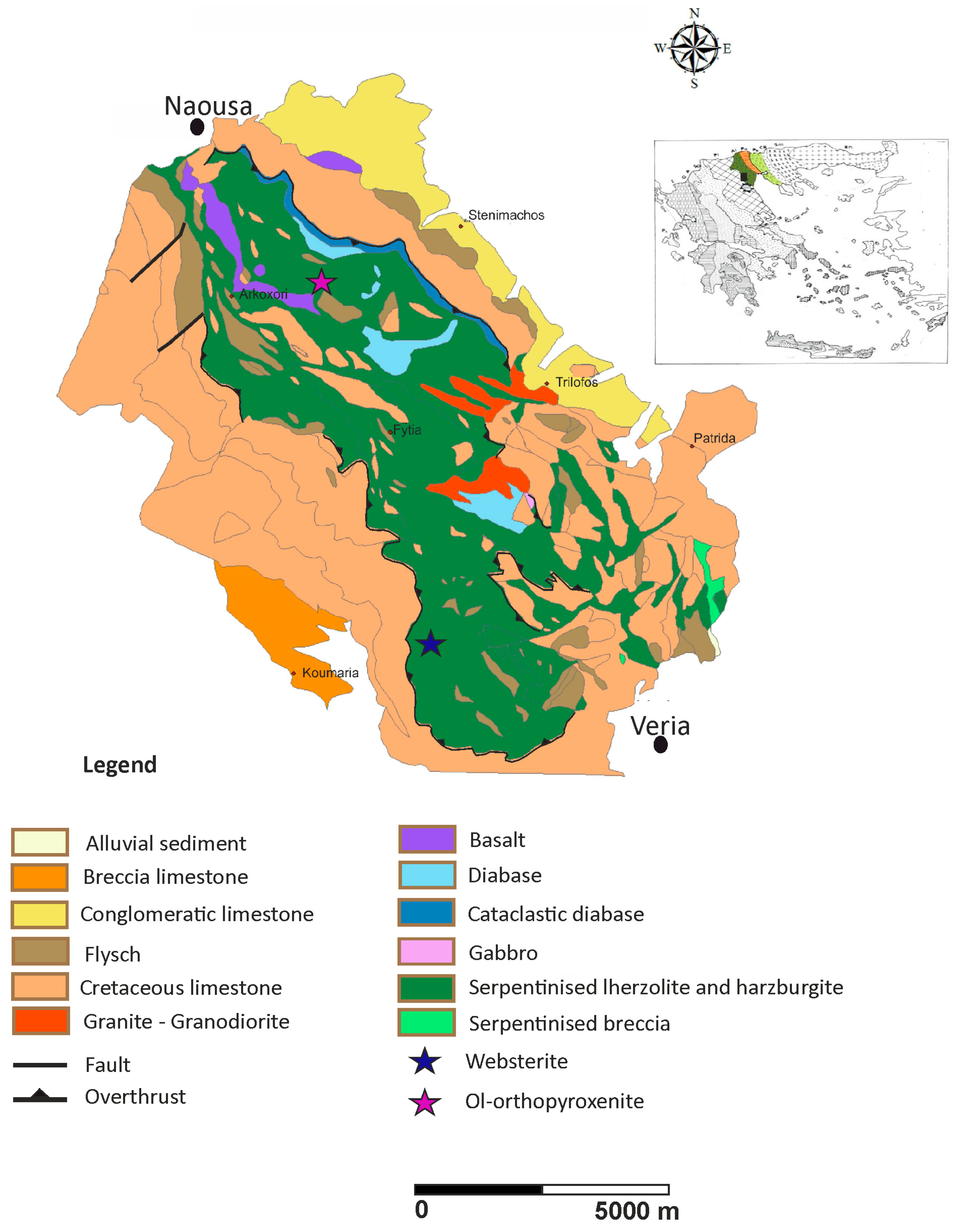
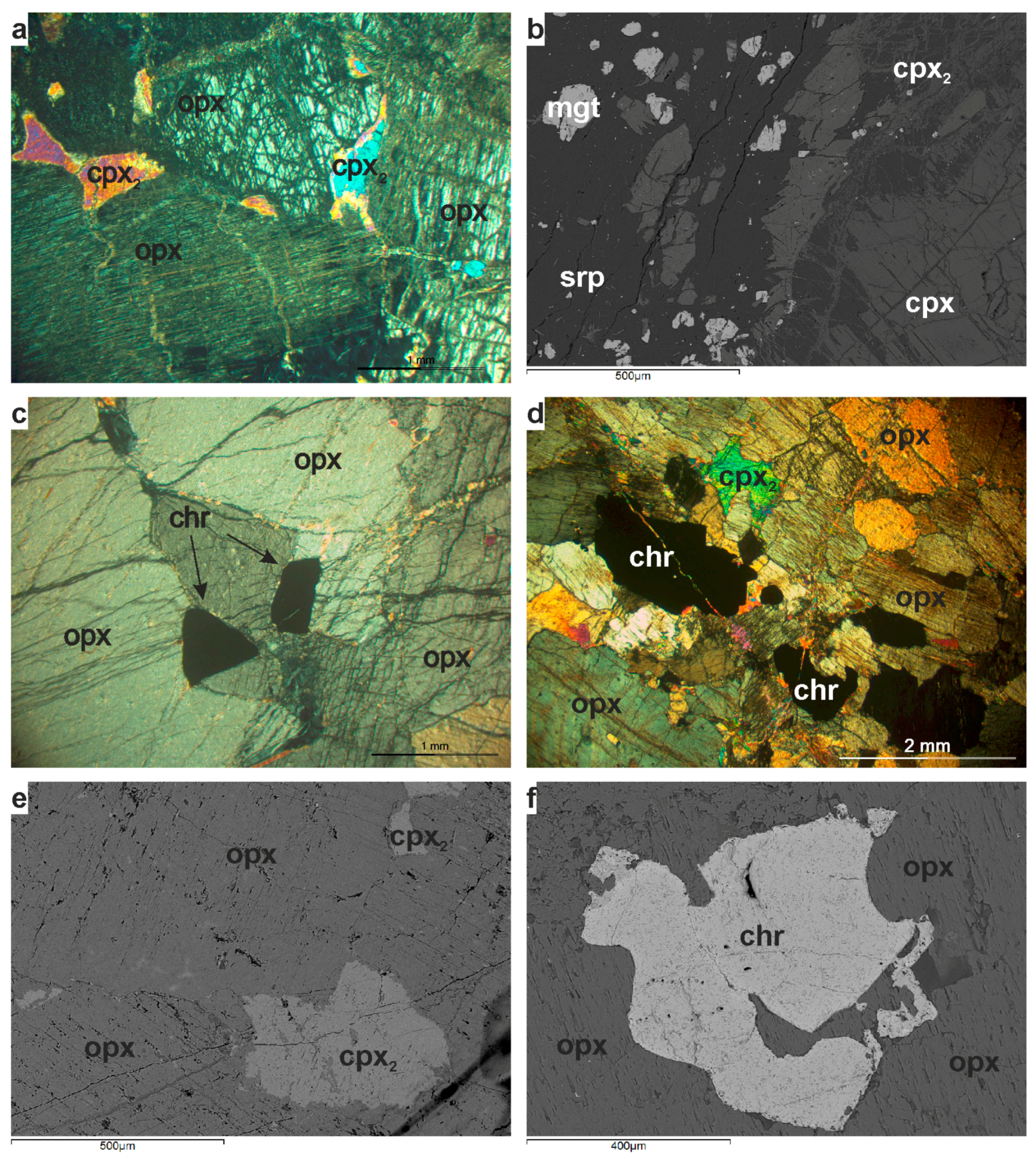
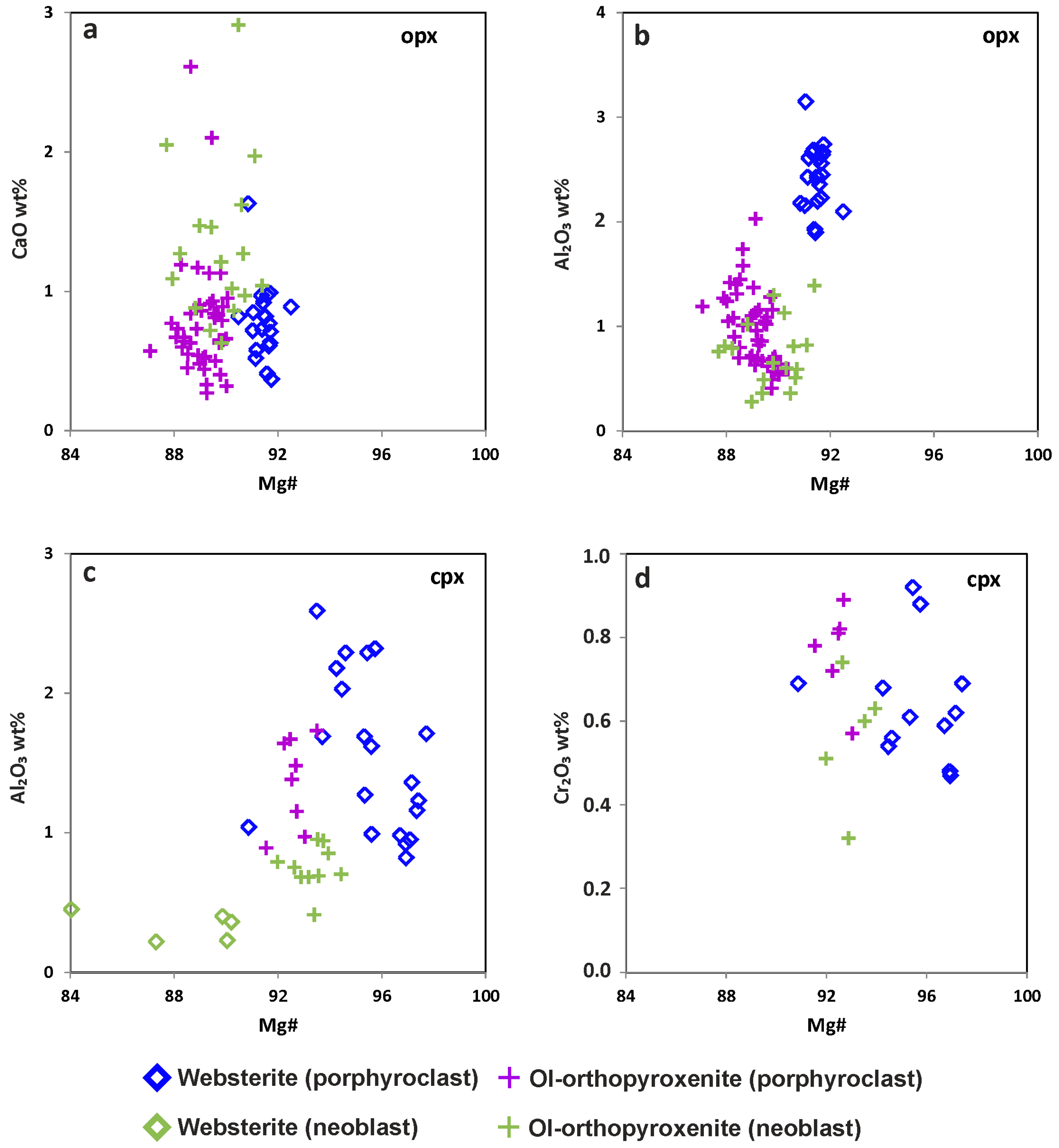
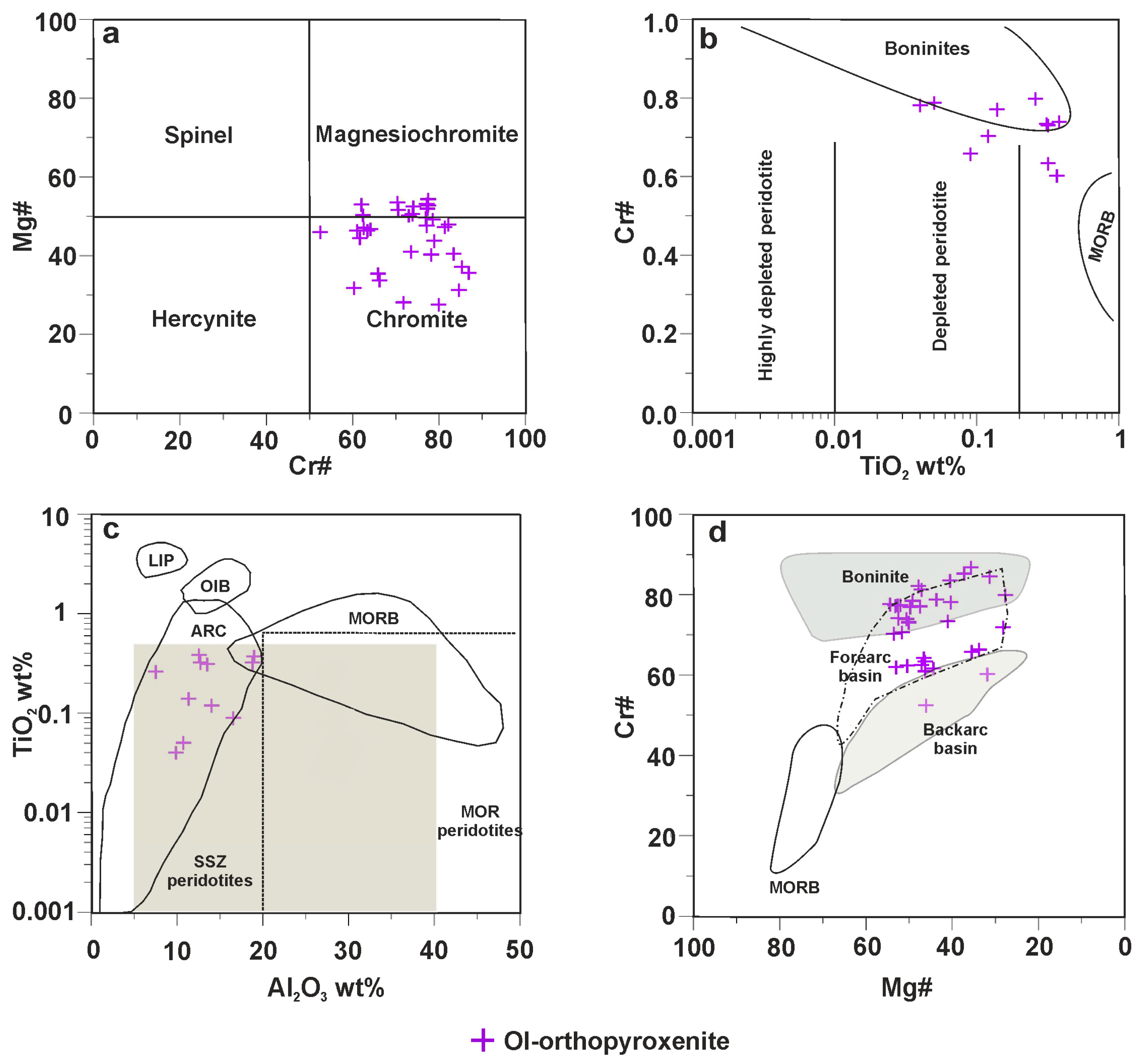
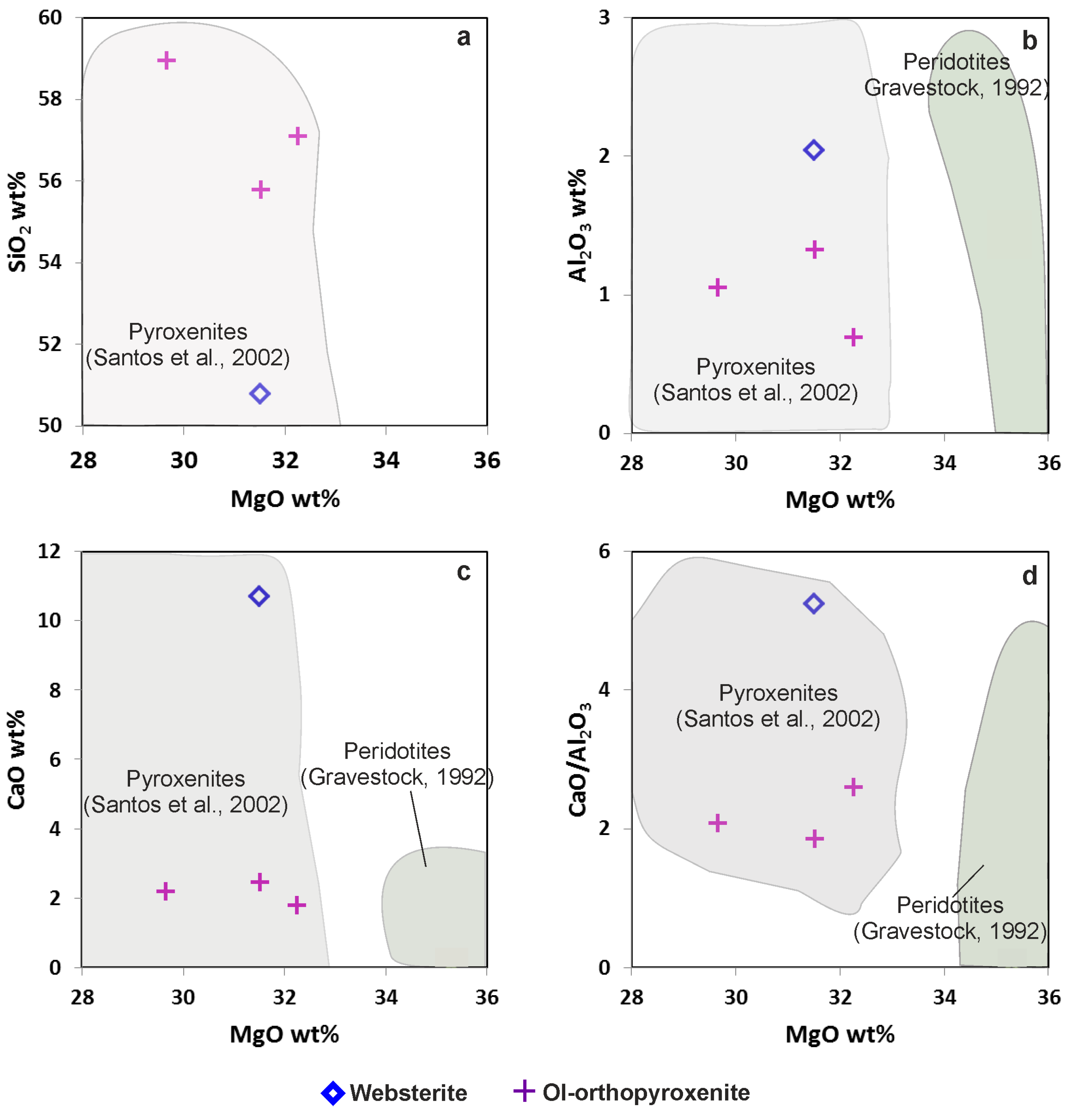

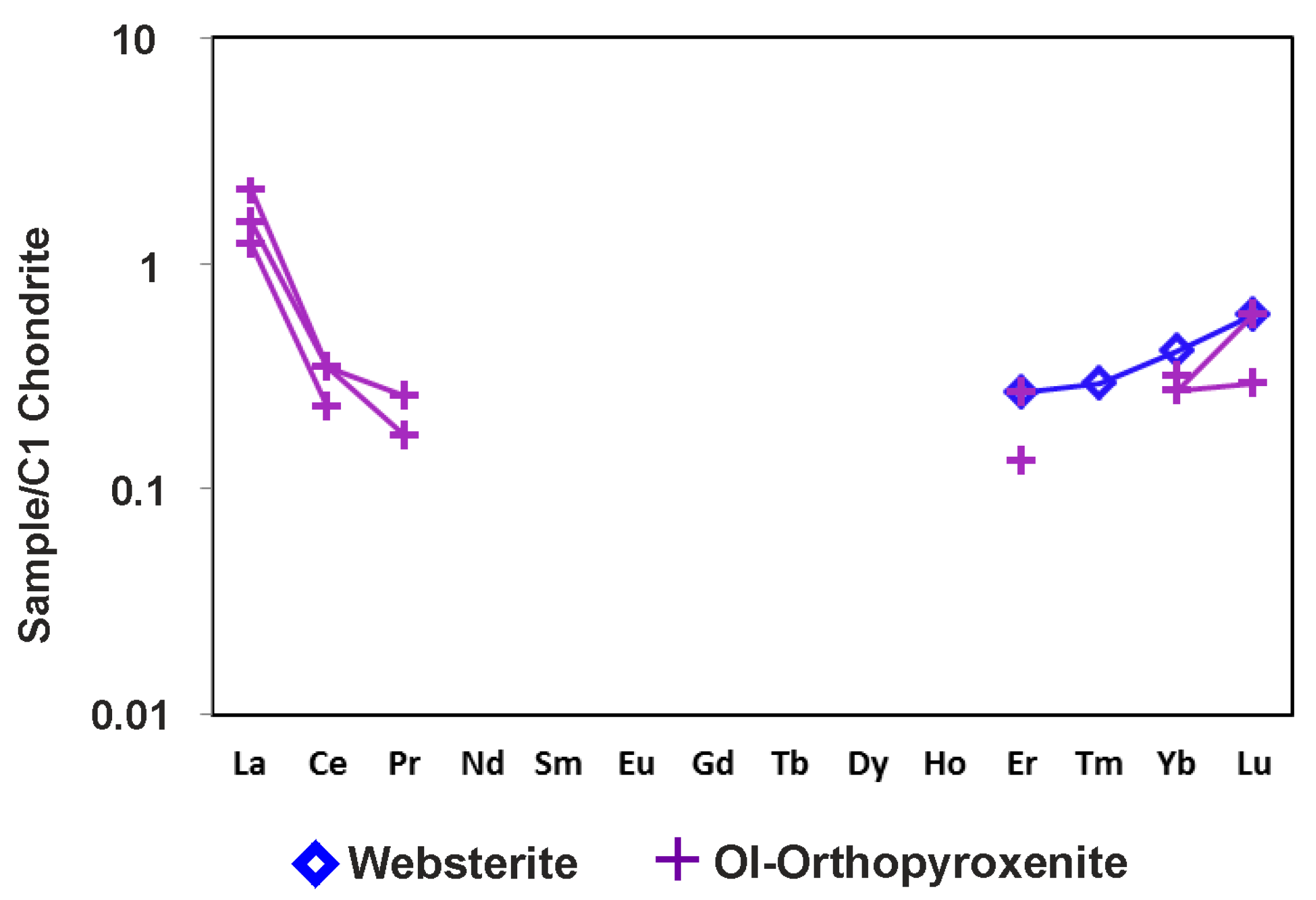
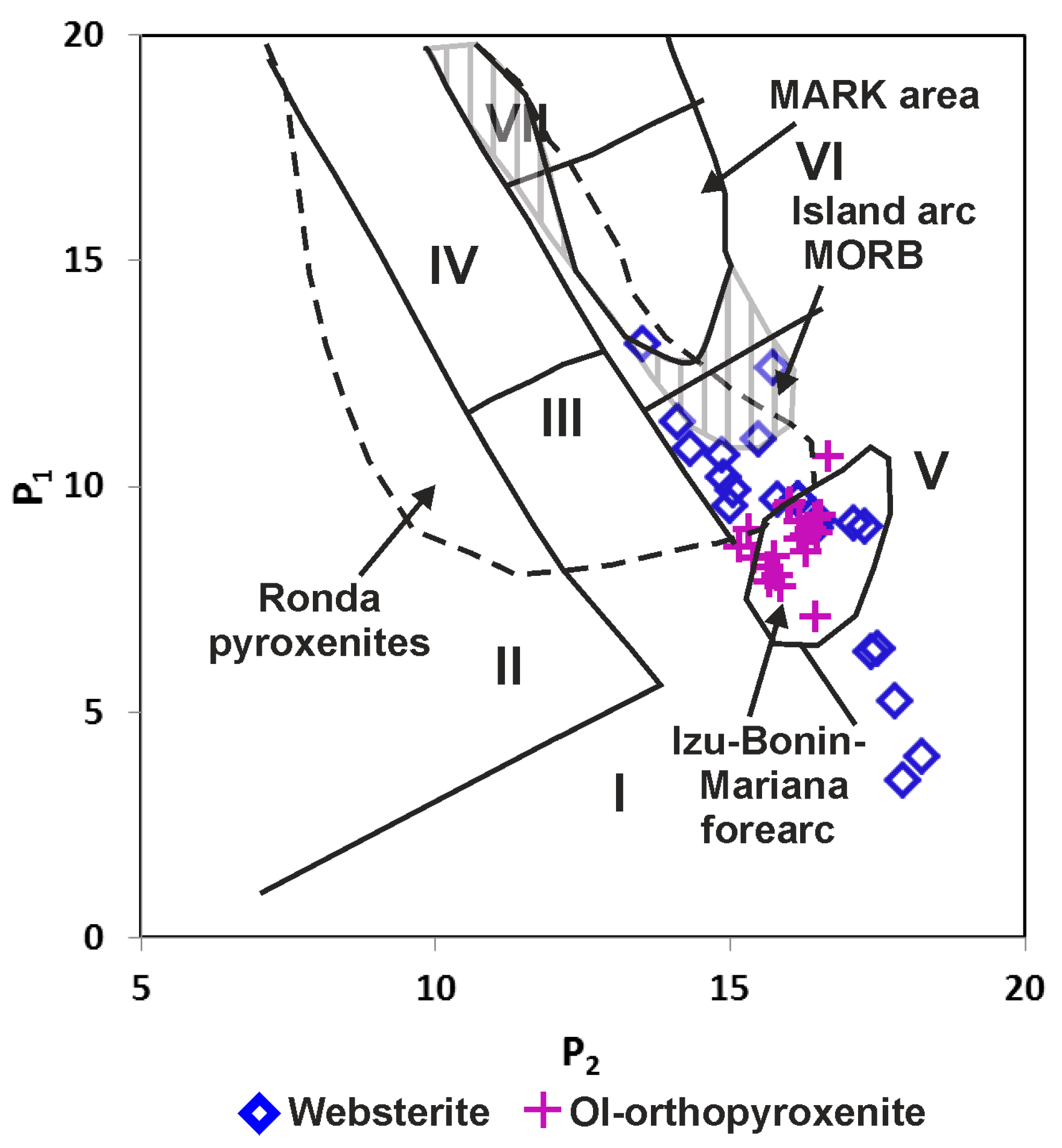
| Sample | BE.6-2 | BE.6-7 | BE.28-2 | BE.28-4 | BE.67-3 | BE.67-17 | BE.67-32 | BE.67B-5 | BE.67B-6 | BE.67B-8 | BE.67B-14 |
|---|---|---|---|---|---|---|---|---|---|---|---|
| Rock-Type | Webst. | Webst. | Ol-Orthop. | Ol-Orthop. | Ol-Orthop. | Ol-Orthop. | Ol-Orthop. | Ol-Orthop. | Ol-Orthop. | Ol-Orthop. | Ol-Orthop. |
| (wt %) | Porph. | Porph. | Porph. | Porph. | Porph. | Porph. | Neobl. | Neobl. | Neobl. | Porph. | Porph. |
| SiO2 | 57.38 | 57.23 | 57.86 | 58.52 | 58.14 | 57.18 | 54.69 | 56.86 | 58.15 | 56.69 | 56.99 |
| TiO2 | - | - | - | - | - | - | - | - | - | - | - |
| Al2O3 | 2.18 | 2.61 | 0.51 | 0.41 | 0.87 | 0.79 | 0.76 | 0.82 | 0.81 | 0.81 | 1.40 |
| FeO | 5.87 | 5.45 | 6.10 | 6.63 | 7.18 | 7.73 | 9.07 | 5.54 | 5.95 | 7.37 | 7.38 |
| MnO | - | - | - | 0.23 | - | - | - | - | - | 0.38 | 0.34 |
| MgO | 32.71 | 33.26 | 33.21 | 33.71 | 33.25 | 32.51 | 32.66 | 31.85 | 32.16 | 31.72 | 32.94 |
| CaO | 1.63 | 0.97 | 1.27 | 0.50 | 0.91 | 1.27 | 2.05 | 1.97 | 1.62 | 1.09 | 0.48 |
| Cr2O3 | - | - | - | 0.29 | - | - | - | 0.45 | 0.45 | 0.29 | 0.40 |
| Sum | 99.77 | 99.52 | 98.95 | 100.29 | 100.40 | 99.48 | 98.32 | 97.49 | 99.14 | 98.35 | 99.93 |
| Structural formula units based on 6 oxygens | |||||||||||
| Si | 1.978 | 1.971 | 1.999 | 1.999 | 2.000 | 1.994 | 1.931 | 2.000 | 2.000 | 2.000 | 1.976 |
| Aliv | 0.022 | 0.029 | 0.001 | 0.001 | 0.000 | 0.006 | 0.000 | 0.000 | 0.000 | 0.000 | 0.024 |
| Alvi | 0.067 | 0.076 | 0.032 | 0.027 | 0.036 | 0.027 | 0.032 | 0.042 | 0.051 | 0.033 | 0.034 |
| Fe3+ | 0.000 | 0.000 | 0.000 | 0.000 | 0.000 | 0.000 | 0.107 | 0.000 | 0.000 | 0.000 | 0.000 |
| Ti | 0.000 | 0.000 | 0.000 | 0.000 | 0.000 | 0.000 | 0.000 | 0.000 | 0.000 | 0.000 | 0.000 |
| Cr | 0.000 | 0.000 | 0.000 | 0.008 | 0.000 | 0.000 | 0.000 | 0.013 | 0.012 | 0.008 | 0.011 |
| Mg | 1.681 | 1.707 | 1.721 | 1.727 | 1.706 | 1.690 | 1.719 | 1.677 | 1.664 | 1.668 | 1.703 |
| Fe2+ | 0.169 | 0.157 | 0.177 | 0.190 | 0.207 | 0.225 | 0.134 | 0.164 | 0.173 | 0.217 | 0.214 |
| Mn | 0.000 | 0.000 | 0.000 | 0.007 | 0.000 | 0.000 | 0.000 | 0.000 | 0.000 | 0.011 | 0.010 |
| Ca | 0.060 | 0.036 | 0.047 | 0.018 | 0.034 | 0.047 | 0.078 | 0.075 | 0.060 | 0.041 | 0.018 |
| En | 88.0 | 89.9 | 88.5 | 88.9 | 87.7 | 86.1 | 84.4 | 87.6 | 87.7 | 86.1 | 87.6 |
| Fs | 8.9 | 8.3 | 9.1 | 10.2 | 10.6 | 11.5 | 11.8 | 8.5 | 9.1 | 11.8 | 11.5 |
| Wo | 3.2 | 1.9 | 2.4 | 0.9 | 1.7 | 2.4 | 3.8 | 3.9 | 3.2 | 2.1 | 0.9 |
| Mg# | 90.9 | 91.6 | 90.7 | 90.1 | 89.2 | 88.2 | 87.7 | 91.1 | 90.6 | 88.5 | 88.8 |
| Sample | BE.6-12 | BE6-13 | BE.6-27 | BE.6-58 | BE.28-12 | BE.28-13 | BE.67-28 | BE.67-21 | BE.67B-1 | BE.67B-4 | BE.67B-9 |
|---|---|---|---|---|---|---|---|---|---|---|---|
| Rock-Type | Webst. | Webst. | Webst. | Webst. | Ol-Orthop. | Ol-Orthop. | Ol-Orthop. | Ol-Orthop. | Ol-Orthop. | Ol-Orthop. | Ol-Orthop. |
| (wt %) | Neobl. | Neobl. | Porph. | Porph. | Porph. | Porph. | Porph. | Neobl. | Neobl. | Neobl. | Neobl. |
| SiO2 | 53.41 | 54.51 | 53.89 | 55.07 | 54.66 | 55.24 | 55.23 | 55.47 | 53.91 | 54.53 | 53.84 |
| TiO2 | - | - | - | - | - | - | - | - | - | - | 0.21 |
| Al2O3 | 1.04 | 0.87 | 1.27 | 1.69 | 0.95 | 0.75 | 0.94 | 0.97 | 1.02 | 0.79 | 0.68 |
| FeO | 3.25 | 3.25 | 1.98 | 2.11 | 2.14 | 2.47 | 2.10 | 2.31 | 2.41 | 2.60 | 2.35 |
| MnO | - | - | - | - | - | - | - | - | 0.03 | 0.25 | 0.08 |
| MgO | 18.14 | 17.75 | 22.76 | 24.13 | 17.35 | 17.44 | 17.68 | 17.31 | 17.48 | 18.37 | 17.82 |
| CaO | 21.98 | 20.95 | 18.07 | 16.85 | 22.33 | 22.82 | 21.96 | 22.49 | 22.61 | 21.36 | 21.75 |
| Cr2O3 | 0.69 | 0.77 | - | 0.61 | 0.60 | 0.74 | - | 0.57 | 0.49 | 0.51 | 0.32 |
| Sum | 98.51 | 98.10 | 97.97 | 100.50 | 98.03 | 99.46 | 97.91 | 99.12 | 97.95 | 98.41 | 97.05 |
| Structural formula units based on 6 oxygens | |||||||||||
| Si | 1.969 | 2.000 | 1.954 | 1.944 | 2.000 | 1.999 | 2.000 | 2.000 | 1.990 | 1.998 | 2.000 |
| Aliv | 0.031 | 0.000 | 0.046 | 0.056 | 0.000 | 0.001 | 0.000 | 0.000 | 0.010 | 0.002 | 0.000 |
| Alvi | 0.014 | 0.038 | 0.008 | 0.014 | 0.050 | 0.038 | 0.064 | 0.057 | 0.035 | 0.033 | 0.030 |
| Fe3+ | 0.000 | 0.000 | 0.038 | 0.025 | 0.000 | 0.000 | 0.000 | 0.000 | 0.000 | 0.000 | 0.000 |
| Ti | 0.000 | 0.000 | 0.000 | 0.000 | 0.000 | 0.000 | 0.000 | 0.000 | 0.000 | 0.000 | 0.006 |
| Cr | 0.020 | 0.022 | 0.000 | 0.017 | 0.017 | 0.021 | 0.000 | 0.016 | 0.014 | 0.015 | 0.009 |
| Mg | 0.997 | 0.973 | 1.230 | 1.270 | 0.950 | 0.944 | 0.966 | 0.937 | 0.962 | 1.004 | 0.987 |
| Fe2+ | 0.100 | 0.100 | 0.022 | 0.037 | 0.066 | 0.075 | 0.064 | 0.070 | 0.074 | 0.080 | 0.073 |
| Mn | 0.000 | 0.000 | 0.000 | 0.000 | 0.000 | 0.000 | 0.000 | 0.000 | 0.001 | 0.008 | 0.003 |
| Ca | 0.868 | 0.826 | 0.702 | 0.637 | 0.879 | 0.888 | 0.862 | 0.875 | 0.894 | 0.839 | 0.866 |
| En | 50.7 | 51.3 | 61.8 | 64.5 | 50.1 | 49.5 | 51.0 | 49.8 | 49.8 | 52.0 | 51.2 |
| Fs | 5.1 | 5.3 | 3.0 | 3.2 | 3.5 | 3.9 | 3.4 | 3.7 | 3.9 | 4.5 | 3.9 |
| Wo | 44.2 | 43.5 | 35.2 | 32.4 | 46.4 | 46.6 | 45.6 | 46.5 | 46.3 | 43.5 | 44.9 |
| Mg# | 90.9 | 90.7 | 95.3 | 95.3 | 93.5 | 92.6 | 93.8 | 93.0 | 92.7 | 92.0 | 92.9 |
| Sample | BE.28-2 | BE.28-5 | BE.28-6 | BE.28-7 | BE.28-8 | BE.28-9 |
|---|---|---|---|---|---|---|
| Rock-Type (wt %) | Ol-Orthop. | Ol-Orthop. | Ol-Orthop. | Ol-Orthop. | Ol-Orthop. | Ol-Orthop. |
| SiO2 | 41.55 | 42.73 | 42.55 | 41.34 | 42.62 | 41.40 |
| TiO2 | - | - | - | - | - | - |
| Al2O3 | - | - | - | - | - | - |
| FeO | 9.75 | 10.46 | 10.19 | 10.19 | 10.45 | 10.31 |
| MnO | - | - | - | - | - | - |
| MgO | 46.93 | 49.10 | 48.31 | 46.53 | 47.62 | 46.22 |
| CaO | - | - | - | - | - | - |
| Cr2O3 | - | - | - | - | - | - |
| NiO | 0.46 | 0.42 | 0.43 | 0.25 | 0.22 | 0.49 |
| Sum | 98.69 | 102.71 | 101.48 | 98.31 | 100.91 | 98.42 |
| Structural formula units based on 4 oxygens | ||||||
| Si | 1.029 | 1.019 | 1.025 | 1.029 | 1.032 | 1.030 |
| Al | 0.000 | 0.000 | 0.000 | 0.000 | 0.000 | 0.000 |
| Ti | 0.000 | 0.000 | 0.000 | 0.000 | 0.000 | 0.000 |
| Mg | 1.732 | 1.745 | 1.736 | 1.726 | 1.719 | 1.715 |
| Fe2+ | 0.202 | 0.209 | 0.205 | 0.212 | 0.212 | 0.215 |
| Mn | 0.000 | 0.000 | 0.000 | 0.000 | 0.000 | 0.000 |
| Ca | 0.000 | 0.000 | 0.000 | 0.000 | 0.000 | 0.000 |
| Ni | 0.009 | 0.008 | 0.008 | 0.005 | 0.004 | 0.010 |
| Total | 2.970 | 2.980 | 2.970 | 2.970 | 2.970 | 2.970 |
| Fo | 89.6 | 89.3 | 89.4 | 89.1 | 89.0 | 88.9 |
| Fa | 10.4 | 10.7 | 10.6 | 10.9 | 11.0 | 11.1 |
| Sample | BE.28-2 | BE.28-3 | BE.28-4 | BE.28-5 | BE.28-6 | BE.67B-9 | BE.67B-14 |
|---|---|---|---|---|---|---|---|
| Rock-Type | Ol-Orthop. | Ol-Orthop. | Ol-Orthop. | Ol-Orthop. | Ol-Orthop. | Ol-Orthop. | Ol-Orthop. |
| (wt %) | Chr | Chr | Chr | Chr | Chr | Chr | Cr-sp |
| TiO2 | - | - | - | - | - | 0.05 | - |
| Al2O3 | 8.98 | 9.28 | 11.64 | 11.38 | 11.59 | 10.70 | 20.00 |
| FeO | 19.77 | 20.06 | 19.61 | 19.47 | 19.52 | 21.63 | 20.59 |
| MnO | 0.44 | - | - | - | - | 0.46 | - |
| MgO | 9.57 | 9.41 | 10.11 | 10.84 | 10.77 | 8.72 | 11.49 |
| K2O | - | - | - | - | - | 0.12 | - |
| Cr2O3 | 61.67 | 60.09 | 57.89 | 57.46 | 58.97 | 59.47 | 48.72 |
| NiO | - | - | - | - | - | - | 0.18 |
| ZnO | - | - | - | - | - | - | 0.19 |
| Sum | 100.43 | 98.84 | 99.25 | 99.15 | 100.85 | 101.15 | 101.17 |
| Structural formula units based on 3 cations | |||||||
| Al | 0.351 | 0.368 | 0.452 | 0.441 | 0.442 | 0.410 | 0.731 |
| Cr | 1.616 | 1.597 | 1.510 | 1.493 | 1.509 | 1.545 | 1.195 |
| Fe3+ | 0.033 | 0.035 | 0.038 | 0.066 | 0.048 | 0.043 | 0.074 |
| Ti | 0.000 | 0.000 | 0.000 | 0.000 | 0.000 | 0.001 | 0.000 |
| 2.000 | 2.000 | 2.000 | 2.000 | 2.000 | 2.000 | 2.000 | |
| Mg | 0.473 | 0.472 | 0.497 | 0.531 | 0.520 | 0.427 | 0.531 |
| Ni | 0.000 | 0.000 | 0.000 | 0.000 | 0.000 | 0.000 | 0.004 |
| Fe2+ | 0.515 | 0.528 | 0.503 | 0.469 | 0.480 | 0.555 | 0.460 |
| Mn | 0.012 | 0.000 | 0.000 | 0.000 | 0.000 | 0.013 | 0.000 |
| Zn | 0.000 | 0.000 | 0.000 | 0.000 | 0.000 | 0.000 | 0.004 |
| K | 0.000 | 0.000 | 0.000 | 0.000 | 0.000 | 0.005 | 0.000 |
| 1.000 | 1.000 | 1.000 | 1.000 | 1.000 | 1.000 | 1.000 | |
| Cr# | 82.2 | 81.3 | 76.9 | 77.2 | 77.3 | 78.9 | 62.0 |
| Mg# | 47.9 | 47.2 | 49.7 | 53.1 | 52.0 | 43.7 | 53.6 |
| Sample | BE.6 | BE.28 | BE.67 | BE.67B |
|---|---|---|---|---|
| Rock-Type | Websterite | Ol-orthopyroxenites | ||
| Major Elements (wt %) | ||||
| SiO2 | 45.76 | 54.79 | 57.65 | 54.79 |
| TiO2 | 0.01 | - | 0.02 | 0.02 |
| Al2O3 | 1.84 | 0.66 | 1.03 | 1.30 |
| Fe2O3t | 4.34 | 7.69 | 7.78 | 8.57 |
| MnO | 0.14 | 0.16 | 0.17 | 0.18 |
| MgO | 28.39 | 30.96 | 29.01 | 30.97 |
| CaO | 9.64 | 1.71 | 2.14 | 2.40 |
| Na2O | - | - | 0.02 | - |
| K2O | - | - | - | - |
| P2O5 | - | - | - | - |
| LOI | 8.8 | 2.9 | 1.2 | 1.1 |
| Total | 98.92 | 98.87 | 99.02 | 99.33 |
| Trace Elements (ppm) | ||||
| Cr | 2812 | 3188 | 2901 | 3147 |
| Co | 66.7 | 75.4 | 66.4 | 69.8 |
| Ni | 1563.4 | 268.4 | 81.3 | 655.0 |
| Cu | 23.9 | 3.2 | 3.9 | 5.4 |
| Zn | 22 | 10 | 6 | 5 |
| Rb | 0.5 | 2.5 | 1.7 | 1.4 |
| Sr | 7.7 | 19.6 | 4.2 | 2.6 |
| Y | 0.4 | 0.3 | 0.3 | 0.2 |
| Zr | 0.1 | 0.3 | 0.5 | 0.4 |
| Nb | 0.1 | - | - | 2.1 |
| Pb | 8.9 | 6.1 | 1.5 | 0.2 |
| Ba | 4 | 5 | 3 | 2 |
| V | 108 | 45 | 92 | 132 |
| Sc | 20 | 13 | 21 | 29 |
| Ga | 3.2 | 3.2 | 1.3 | 0.6 |
| Hf | - | - | - | - |
| As | - | 0.6 | - | - |
| Hg | - | 0.01 | 0.02 | - |
| Ta | - | - | - | - |
| Th | - | - | - | - |
| U | - | - | - | - |
| Be | - | 2 | - | - |
| Au (ppb) | 2.3 | 3.3 | 2.2 | - |
| Rare Earth Elements (ppm) | ||||
| La | - | 0.5 | 0.7 | 0.4 |
| Ce | - | 0.3 | 0.3 | 0.2 |
| Pr | - | 0.02 | 0.03 | - |
| Nd | - | - | - | - |
| Sm | - | - | - | - |
| Eu | - | - | - | - |
| Gd | 0.05 | - | - | - |
| Tb | - | - | - | - |
| Dy | - | - | - | 0.09 |
| Ho | - | - | - | - |
| Er | 0.06 | 0.03 | 0.03 | 0.06 |
| Tm | 0.01 | - | - | - |
| Yb | 0.09 | 0.07 | 0.06 | 0.06 |
| Lu | 0.02 | - | 0.02 | 0.01 |
| Mg# | 87.9 | 81.7 | 80.6 | 80.1 |
| CaO/Al2O3 | 5.24 | 2.59 | 2.08 | 1.85 |
| Zr/Y | 0.25 | 1.00 | 1.67 | 2.00 |
| La/Lu | - | 7.14 | 11.67 | 6.67 |
| Sample | BE.6 | BE.28 | BE.67 | BE.67B |
|---|---|---|---|---|
| Rock-Type | Websterite | Ol-orthopyroxenite | ||
| Opx-Cpx thermometry (°C) Wood and Bano [47] | 1136 | 972 | 974 | 974 |
© 2017 by the authors. Licensee MDPI, Basel, Switzerland. This article is an open access article distributed under the terms and conditions of the Creative Commons Attribution (CC BY) license (http://creativecommons.org/licenses/by/4.0/).
Share and Cite
Rogkala, A.; Petrounias, P.; Tsikouras, B.; Hatzipanagiotou, K. New Occurrence of Pyroxenites in the Veria-Naousa Ophiolite (North Greece): Implications on Their Origin and Petrogenetic Evolution. Geosciences 2017, 7, 92. https://doi.org/10.3390/geosciences7040092
Rogkala A, Petrounias P, Tsikouras B, Hatzipanagiotou K. New Occurrence of Pyroxenites in the Veria-Naousa Ophiolite (North Greece): Implications on Their Origin and Petrogenetic Evolution. Geosciences. 2017; 7(4):92. https://doi.org/10.3390/geosciences7040092
Chicago/Turabian StyleRogkala, Aikaterini, Petros Petrounias, Basilios Tsikouras, and Konstantin Hatzipanagiotou. 2017. "New Occurrence of Pyroxenites in the Veria-Naousa Ophiolite (North Greece): Implications on Their Origin and Petrogenetic Evolution" Geosciences 7, no. 4: 92. https://doi.org/10.3390/geosciences7040092






